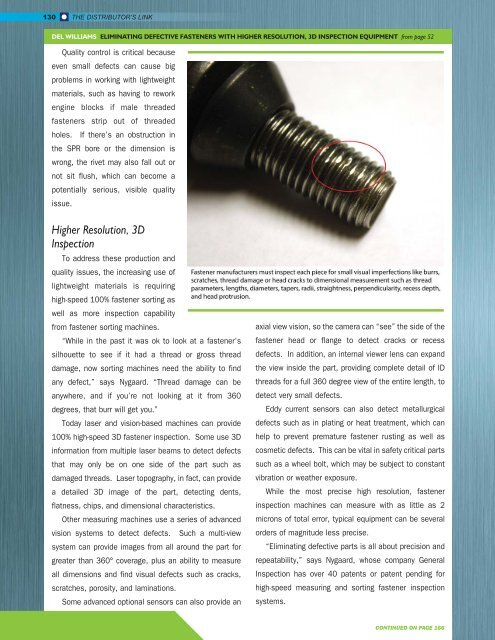WINTER 2016
Distributor's Link Magazine Winter Issue 2016 / Vol 39 No1
Distributor's Link Magazine Winter Issue 2016 / Vol 39 No1
You also want an ePaper? Increase the reach of your titles
YUMPU automatically turns print PDFs into web optimized ePapers that Google loves.
130 THE DISTRIBUTOR’S LINK<br />
DEL WILLIAMS ELIMINATING DEFECTIVE FASTENERS WITH HIGHER RESOLUTION, 3D INSPECTION EQUIPMENT from page 52<br />
Quality control is critical because<br />
even small defects can cause big<br />
problems in working with lightweight<br />
materials, such as having to rework<br />
engine blocks if male threaded<br />
fasteners strip out of threaded<br />
holes. If there’s an obstruction in<br />
the SPR bore or the dimension is<br />
wrong, the rivet may also fall out or<br />
not sit flush, which can become a<br />
potentially serious, visible quality<br />
issue.<br />
Higher Resolution, 3D<br />
Inspection<br />
To address these production and<br />
quality issues, the increasing use of<br />
lightweight materials is requiring<br />
high-speed 100% fastener sorting as<br />
well as more inspection capability<br />
from fastener sorting machines.<br />
“While in the past it was ok to look at a fastener’s<br />
silhouette to see if it had a thread or gross thread<br />
damage, now sorting machines need the ability to find<br />
any defect,” says Nygaard. “Thread damage can be<br />
anywhere, and if you’re not looking at it from 360<br />
degrees, that burr will get you.”<br />
Today laser and vision-based machines can provide<br />
100% high-speed 3D fastener inspection. Some use 3D<br />
information from multiple laser beams to detect defects<br />
that may only be on one side of the part such as<br />
damaged threads. Laser topography, in fact, can provide<br />
a detailed 3D image of the part, detecting dents,<br />
flatness, chips, and dimensional characteristics.<br />
Other measuring machines use a series of advanced<br />
vision systems to detect defects.<br />
Such a multi-view<br />
system can provide images from all around the part for<br />
greater than 360° coverage, plus an ability to measure<br />
all dimensions and find visual defects such as cracks,<br />
scratches, porosity, and laminations.<br />
Some advanced optional sensors can also provide an<br />
axial view vision, so the camera can “see” the side of the<br />
fastener head or flange to detect cracks or recess<br />
defects. In addition, an internal viewer lens can expand<br />
the view inside the part, providing complete detail of ID<br />
threads for a full 360 degree view of the entire length, to<br />
detect very small defects.<br />
Eddy current sensors can also detect metallurgical<br />
defects such as in plating or heat treatment, which can<br />
help to prevent premature fastener rusting as well as<br />
cosmetic defects. This can be vital in safety critical parts<br />
such as a wheel bolt, which may be subject to constant<br />
vibration or weather exposure.<br />
While the most precise high resolution, fastener<br />
inspection machines can measure with as little as 2<br />
microns of total error, typical equipment can be several<br />
orders of magnitude less precise.<br />
“Eliminating defective parts is all about precision and<br />
repeatability,” says Nygaard, whose company General<br />
Inspection has over 40 patents or patent pending for<br />
high-speed measuring and sorting fastener inspection<br />
systems.<br />
CONTINUED ON PAGE 166

















